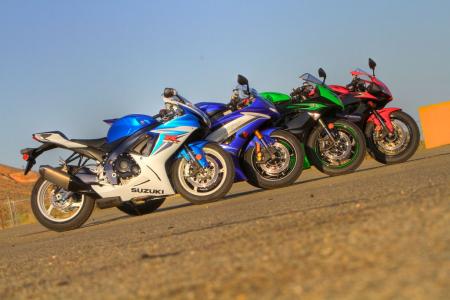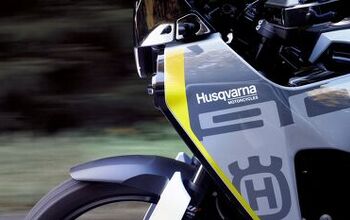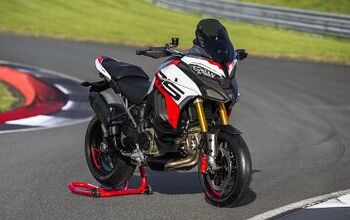2011 Supersport Shootout - Street [Video] - Motorcycle.com
The sleek lines, svelte figure, light weight and high-horsepower engine of the modern supersport motorcycle, along with the race-bred origins of the majority of the components found on these two-wheelers, project an image that says, “Go as fast as possible! Win that race!”
There’s a prevailing platitude among two-wheel pundits that says this type of motorcycle is impractical for everyday use by the non-racing everyday rider. And while not in direct conflict with this theory of impracticality, an equally popular assertion that gets bandied about alleges that of the sportbikes purchased, most will never turn a wheel on a closed course and only ever exist under control of local vehicle codes rather than club-racing rules.
So, after selecting the all-new 2011 Suzuki GSX-R600 as our top choice for use at the racetrack in our 2011 Supersport Shootout – Track comparison in which the new Gixxer went toe-to-toe with the Honda CBR600RR, Kawasaki ZX-6R and Yamaha R6, we now move on to Phase 2 of this often-annual examination in which we examine how they perform in a street environment.
It’s time to see if the fresh-faced Gixxer Sixxer can make it a sweep in 2011 at Motorcycle.com or if we somehow found one of the three other – and older! – bikes in this brawl a better streetable package.
And now, a word from Mr. Dyno
Patient readers, receive your reward.
Given the strength of the Kawasaki engine the last time we tested this full batch of Japanese 600cc sportbikes, we weren’t so surprised to learn that the Ninja retains its title this year as Most Powerful. Add to that honor, Mr. Linear.
With a best pull of 110.7 hp at 13,900 rpm, the Ninja 6R managed to keep at bay the Yamaha’s minimally updated engine, which while generating a worthwhile 7.0 hp improvement from when we last tested it as a 2009 model, still came up a few ponies shy with 107.2 hp at 13,600 rpm. For the overhauled GSX-R600, Suzuki touts an improvement to low- and mid-range power with a crankshaft peak horsepower figure of 123. That should’ve resulted in a peak rear wheel horsepower reading in the neighborhood of 110 hp or slightly less. The reality is a bit sobering.
The 2009 GSX-R600 we tested gave a peak reading of 102.7 hp at 13,400 rpm, where the updated 2011 model managed a best run of 102.2 hp at 13,700 rpm. We’ll just call it a wash there. Additionally, we didn’t observe a noteworthy increase in mid-range for the new Gixxer during dyno runs compared to when we lasted dyno’d the previous model.
But looking across the rev range, as well as during the reality check of riding, the GSX-R mill is our second choice next to the ZX for best engine, as the Suzuki provides linear pull that rivals the Ninja, and for a short period is more powerful than the Ninja.
“The powerbands of the ZX and Gixxer make excellent sparring partners,” says veteran sportbike shootout participant Kevin. “The Suzuki has best-in-class power from 4800 to 7000 rpm, while the Ninja is tops from 7100 to 8700 rpm, then they nearly match each other until 13K rpm when the Kawi becomes the clear class leader.”
Our biggest surprise this year came when we saw the Honda’s dyno figures.
Since the CBR is essentially the same bike as from two years ago, we were looking for a peak reading in the neighborhood of 97 hp, which is what we saw with its 97.0 hp at 14,400 rpm. However, what we didn’t expect to see was a graph line that revealed a less-linear CBR600RR in 2011 than what we rode in 2009.
With the exception of right off idle until the upper 4K rpm range, and a span from approximately 6800 to 8800 rpm, where the CBR is largely more powerful than the Yamaha, the Honda otherwise came up short to the R6’s wavy gravy powerband. This is quite a shift from 2009 when the CBR showed a much more tractable powerband, while the then-softer and seemingly smoother R6 lagged behind considerably.
Furthermore, while the CBR achieves more than 95% of peak power starting around 12,200 rpm and carries it to its 15,200-rpm rev limiter, it doesn’t continue building power as the other bikes do but rather stays flat. The saving grace for the Honda this time around is that it stays pretty close to the GSX-R and Kawasaki for a good chunk of the mid-range.
Quite a strange brew, but as you’ll soon read, what we collect in the lab for the sake of gathering objective data is often not wholly representative of the character and quality of each motorcycle when a rider is in the saddle coordinating the various operations required to make a bike go.
Let’s carry on then…
More by Pete Brissette































Comments
Join the conversation